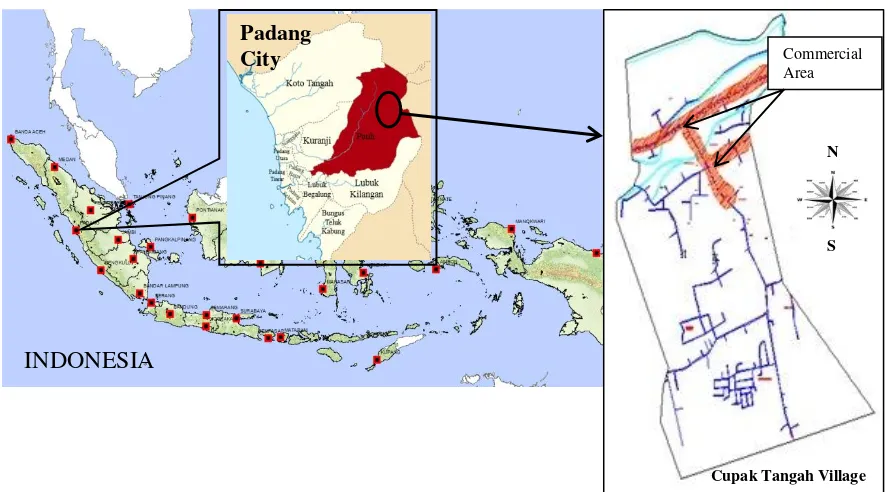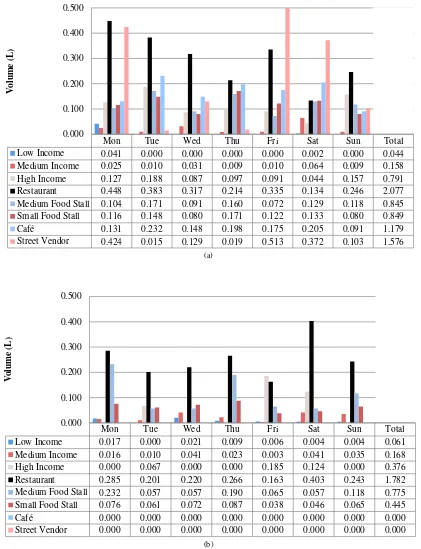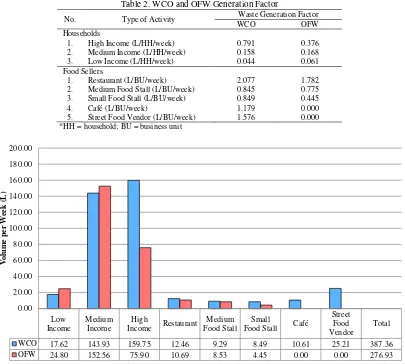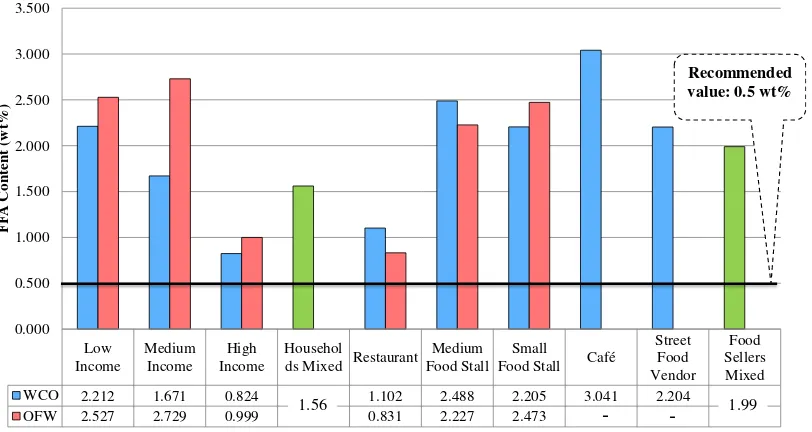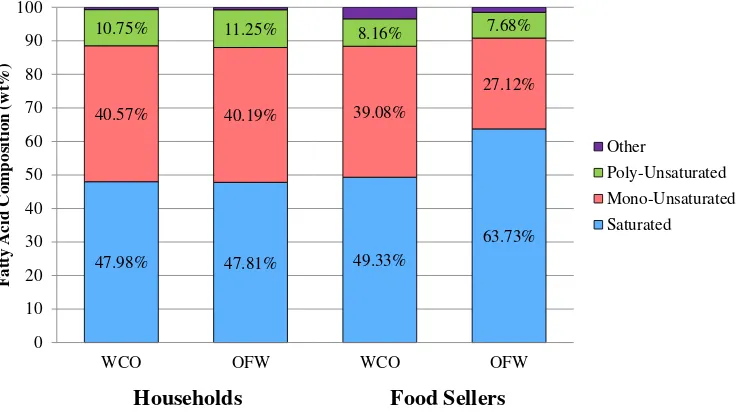International Seminar on Collaboration Research
“Study on Urban Environmental Management of Indonesian Cities Considering
Applicability o
f ‘Kitakyushu Model’ as Japanese Advanced Eco
-
model City”
Kitakyushu, Japan, 5th June 2015
Proceedings of International Seminar on Collaboration Research
The Potential of Cooking Oil and Oily Food Wastes as
Alternative Biodiesel Feedstock and People Participation for
Collecting Them in Padang Municipality:
Case Study of Cupak Tangah Village
Fadjar Goembira
a*, Taufiq Ihsan
a, Adjar Pratoto
b, Stella Juwita
a, Andrean Syailendra
aaDepartment of Environmental Engineering Faculty of Engineering, Andalas University Kampus Unand Limau Manis, Padang 25163 bDepartment of Mechanical Engineering Faculty of Engineering Andalas University, Kampus Unand Limau Manis, Padang 25163
INDONESIA
Abstract
Indonesia is highly dependent on the use of fossil fuels to support its development. However, the country could no longer provide national energy demand by its own supply, thus becoming a net oil importer from 2004. In order to solve this issue, the Government has set policy on the use of biodiesel. Nevertheless, current biodiesel production solely relies on the use of crude palm oil that can compete with the need of the oil for food demand. This study has, therefore, been conducted to know the possibility of using waste cooking oil (WCO) and oily food waste (OFW) as alternative biodiesel feedstock in a village located in Padang Municipality. The surveyed WCO and OFW generators comprised of households and commercial activities (food sellers) within the village. Direct waste sampling for its amount quantification was carried out based on the Indonesian standard for municipal waste sampling (SNI No. 19-3964-1994), while questionnaire survey was done to know the existing practices in handling the wastes and the likelihood of people participation in collecting them. Moreover, WCO and OFW samples were measured in laboratory for its free fatty acid (FFA) content, water content and fatty acid profile. Furthermore, information gathering from stakeholders involved in re-using WCO as biodiesel feedstock in Kitakyushu City has been conducted. As the results, it is estimated that 387.36 and 276.93 liters/week of WCO and OFW, correspondingly, are produced in Cupak Tangah Village. Direct discharging of the wastes into the sewer are practiced by 70% of households and 13% of food sellers. Around 72% of households re-used the WCO once, however, 79% of the food sellers do the same practice for more than 5 times. As for the possible participation to collect the waste, in average, 70% of both households and food sellers showed willingness to participate, although in some cases they requested for some conditions to be fulfilled. While for the waste properties, both wastes have FFA and water contents higher than 0.5 and 0.06wt%, respectively, which require two-step biodiesel production method with waste dewatering process in advance. The fatty acid profile shows some possible solidification of produced biodiesel at low temperature. Based on comparative study done in Kitakyushu city, some actions must be taken by relevant stakeholders to implement biodiesel production from WCO and OFW in Padang Municipality.
Keywords : Biodiesel, WCO, OFW, People Participation, Padang
1.Introduction
Indonesia with its 251 million population [1] needs vast amount of energy source to sustain its development. However, since 2004 Indonesia has become a net oil importer country that must fulfill some of its energy demand by importing it. This situation has given additional burden for the Government, particularly when there is an increase in the US Dollar exchange towards the Rupiah currency.
Corresponding author. Tel.: +62-751-72497; fax: +62-751-72566.
as an alternative fuel to petro-diesel. The use of biodiesel is claimed as capable to reduce fossil fuel imports, but it is also alleged as an environmentally friendly practice as it can reduce carbon emissions.
Recently, a newer regulation from the same ministry has been issued to accelerate the increase of biodiesel amount used domestically [3]. For instance, the implementation of 10% biodiesel blending with petro-diesel (B10) for transportation sector has been accelerated from fiscal year 2020 to 2014, while for 20% blending (B20) will be implemented in 2016 by the newer regulation instead of 2025 as planned by the former regulation.
However, at the moment, biodiesel producers in Indonesia only utilize crude palm oil (CPO) as the main biodiesel feedstock [4], thus, both regulations might lead to some consequences. First, the use of CPO has triggered land conversion into oil palm plantations. The changes are not only to the lands that were formerly used as agriculture lands, such as paddy fields, but also to some forest and peat land areas. Secondly, in order to clear the lands, some people burn them and often created forest fires. Both practices are not only increasing the amount of carbon emission, but also increasing the risk of food crisis in Indonesia [5]. There will be reduction of paddy field areas and the use of CPO as biodiesel feedstock will further increase the competition between lands/crops for food and lands/crops for energy.
Oil and fats consumed in West Sumatera Province are higher than the other provinces in Indonesia, because of its oily-food eating habits [6]. Some of those oil and fats will eventually become wastes that can potentially be converted into biofuel [7]. Therefore, this study was done to know the potential of waste cooking oil (WCO) and oily food waste (OFW) from households and commercial food activities (food sellers) as biodiesel feedstock in a village located in Padang Municipality.
2.Methodology
2.1.Location of Study
Cupak Tangah Village is located in Pauh District of Padang Municipality that has total population of 8,546 people or 1,516 households. There are 52 types of food commercial activities that potentially generate WCO and OFW. The location of Cupak Tangah Village in Padang City of West Sumatera Province is shown in Figure 1.
Figure 1 Location of Study
2.2Determination of Sample Number
This study comprised of questionnaire distribution to some respondents, collection of WCO and OFW samples and laboratory analysis of those samples. The questionnaire study was aimed to find out the existing Commercial Area
N
S
INDONESIA
Padang
City
Goembira et al / Proceedings of International Seminar on Collaboration Research (2015)
habit on cooking oil use and the handling of WCO and OFW by both households and food sellers. The collection of WCO and OFW samples was conducted to find out the waste amount within a week period of time. Lastly, the laboratory analysis was done to evaluate some important waste parameters that will influence both biodiesel production process and some of the fuel properties. The recapitulation of sample number is shown in Table 1.
Table 1. Recapitulation of Sample Number
No. Type of Activity ** Based on SNI 19-3964-1994[8]
*** Based on Stratified Random Sampling Method
The classification of income level was based on Indonesian Bureau of Statistics standard. Meanwhile, the classification of food sellers refers to three regulations, i.e., Republic of Indonesia Laws No. 20/2008 about Micro, Small and Medium Enterprises, Republic of Indonesia Minister of Health Regulation No. 1098/2003 about Hygiene Requirements for Restaurants, and Republic of Indonesia Minister of Culture and Tourism Regulation No. 87/2010 about Registration Procedure for Food and Beverage Enterprises.
2.3 Laboratory Analysis of Samples
Laboratory analysis was done to know some important parameters related to biodiesel production method and expected biodiesel cold-flow properties. Those parameters are water content, free fatty acid (FFA) content and fatty acid profile. Water content and FFA content were measured by using gravimetric and titration method, respectively. While for fatty acid profile, the measurement was done by using Gas Chromatography-Mass Spectrometry (GC-MS).
3.Results and Discussion
3.1 Estimation of WCO and OFW Quantity
Direct measurement of WCO and OFW generation was done in order to know the amount of those waste coming from both households and food sellers per day during a week period of time. This measurement was also conducted to see the fluctuation of the waste generation. Number of samples for carrying out the waste quantity measurement is shown in Table 1. The results of direct WCO and OFW amount generated per day in a week are presented in Figure 2 (a) and (b), respectively.
As can be seen from Figure 2 (a), the average amounts of WCO generated from households and food sellers were from 0.044 to 0.791 liter per week and from 0.845 to 2.077 liter per week, correspondingly. The restaurant generated more WCO as compared to other waste generators due most likely to the number of food servings that must be higher for that activity. While for the low income households that generate the least amount of WCO, it might be due to the lack ability to purchase the cooking oil or it might also be related to the WCO re-using habit in preparing meals. Figure 2 (a) also shows the weekly fluctuation of WCO generation from households and food sellers. The highest amount of WCO generation from households was on Tuesday, while for the food seller it happened on Friday.
(a)
(b)
Figure 2. Comparison of Average WCO and OFW Amount Generated in a Week (a) WCO; (b) OFW
Based on data shown in Figures 2 (a) and (b) and assuming that the samples represent the condition of population in the study area, waste generation factors for both WCO and OFW were obtained, and shown in Table 2. The factors were then multiplied by the total population of each waste generator as presented in Table 1. Thereby, the estimation of total amount of WCO and OFW per week in the study area could be obtained, and shown in Figure 3.
Mon Tue Wed Thu Fri Sat Sun Total
Low Income 0.041 0.000 0.000 0.000 0.000 0.002 0.000 0.044
Medium Income 0.025 0.010 0.031 0.009 0.010 0.064 0.009 0.158
High Income 0.127 0.188 0.087 0.097 0.091 0.044 0.157 0.791
Restaurant 0.448 0.383 0.317 0.214 0.335 0.134 0.246 2.077
Medium Food Stall 0.104 0.171 0.091 0.160 0.072 0.129 0.118 0.845 Small Food Stall 0.116 0.148 0.080 0.171 0.122 0.133 0.080 0.849
Café 0.131 0.232 0.148 0.198 0.175 0.205 0.091 1.179
Street Vendor 0.424 0.015 0.129 0.019 0.513 0.372 0.103 1.576
0.000 0.100 0.200 0.300 0.400 0.500
V
o
lum
e (L)
Mon Tue Wed Thu Fri Sat Sun Total
Low Income 0.017 0.000 0.021 0.009 0.006 0.004 0.004 0.061
Medium Income 0.016 0.010 0.041 0.023 0.003 0.041 0.035 0.168
High Income 0.000 0.067 0.000 0.000 0.185 0.124 0.000 0.376
Restaurant 0.285 0.201 0.220 0.266 0.163 0.403 0.243 1.782
Medium Food Stall 0.232 0.057 0.057 0.190 0.065 0.057 0.118 0.775
Small Food Stall 0.076 0.061 0.072 0.087 0.038 0.046 0.065 0.445
Café 0.000 0.000 0.000 0.000 0.000 0.000 0.000 0.000
Street Vendor 0.000 0.000 0.000 0.000 0.000 0.000 0.000 0.000
0.000 0.100 0.200 0.300 0.400 0.500
V
o
lum
Goembira et al / Proceedings of International Seminar on Collaboration Research (2015)
Table 2. WCO and OFW Generation Factor
No. Type of Activity Waste Generation Factor
WCO OFW 2. Medium Food Stall (L/BU/week) 0.845 0.775 3. Small Food Stall (L/BU/week) 0.849 0.445
4. Café (L/BU/week) 1.179 0.000
5. Street Food Vendor (L/BU/week) 1.576 0.000 *HH = household; BU = business unit
Figure 3. Estimation of Total WCO and OFW Amounts Generated per Week from Different Sources
From Figure 3 we can see the estimation of WCO and OFW amount from different sources within the study area. It is estimated that the highest amount of WCO and OFW comes from medium and high income households. This situation is most likely due to the population number of those sources, particularly when we compare it with the food seller sources. Based on the figure, approximately 387.36 and 276.93 liters/week of WCO and OFW are generated, correspondingly, in the study area.
3.2 Existing Practice in Using Cooking Oil and Handling the WCO and OFW
The existing WCO handling habits among respondents are presented in Figure 4. Most households (70%) directly discharged the waste into the sewer, while only 13% of food sellers do the same thing. Even though at the moment there is no regulation that bans this waste handling practice, however it is not acceptable due to the risk of destruction at the sewerage system and water pollution issues [9,10]. On the other hand, the re-using of WCO showed a contrast figure, i.e., around 11.7 and 74% conducted by households and food sellers,
The questionnaire survey further explored the current practice of respondents in re-using cooking oil. The results are shown in Figure 5. Based on the figure, most household respondents (71.7%) re-used the cooking oil once, while the rest of them (around 27%) re-using them more frequently. On the other hand, almost all food sellers re-used the cooking oil more than once. Around 26% of food sellers even re-use the cooking oil more than 8 times. Re-using cooking oil has been studied by many researchers [11,12,13] with a similar conclusion, i.e., it causes health problems due to the formation of free radicals during the re-heating of the cooking oil.
Figure 5. Cooking Oil Re-using Habit among Respondents (a) Households; (b) Food Sellers
3.3 Possible People Participation in Collecting WCO and OFW
The results of questionnaire survey to find out the likelihood of people participation to collect WCO and OFW are shown in Figure 6. Most households (76.70%) are willing to participate in collecting the waste, although they required the waste containers to be provided by other parties. As for the food sellers, around 69% will join to collect the wastes, but half of them (32%) have some conditions that must be fulfilled, i.e., institutions that want to utilize the waste must give them money as a compensation to their participations. Only 5% household respondents are against the proposed plan, while the number is higher for the food seller respondents (16%). Hesitant respondents for households and food sellers are 10 and 15%, respectively.
Figure 6. Possible People Participation on Collecting WCO and OFW (a) Households; (b) Food Sellers
3.4 Evaluation of WCO and OFW Properties
The chemical of WCO and OFW is necessary to be evaluated, in order to plan biodiesel production method and to predict, to a certain extend biodiesel cold-flow and oxidation stability properties, in particular. Some crucial parameters that were evaluated are free fatty acid (FFA) content, water content and fatty acid profile of the wastes. FFA content relates to the possibility of using alkali-catalyzed method that is very common to be used due to its relatively low reaction temperature and short reaction time [14]. Whereas for the water content parameter, it is evaluated to find out the likelihood of applying acid-catalyzed method, which is less susceptible to the high FFA content in biodiesel feedstock. Meanwhile, evaluation of fatty acid profile will show the proportion of saturated, mono-unsaturated, and poly-unsaturated fatty acids that present in the WCO and OFW as the biodiesel feedstock. The results of WCO and OFW chemical property evaluation is presented in Figures 7, 8, and 9.
1 time, 4%
2-4 times,
17%
5-8 times, 53% >8 times,
26%
1 time, 71.70% 2-4 times,
26.60% 5-8 times,
1.70%
Willing to Participate with Some Conditions, 76.70% Hesitate to
Participate, 10.00% Not Willing to
Participate, 5.00% Other, 8.30%
Willing to Participate with Some Conditions, 32%
Hesitate to Participate, 15% Not Willing to
Participate, 16% Willing to Participate
Voluntarily, 37%
(a) (b)
Goembira et al / Proceedings of International Seminar on Collaboration Research (2015)
Figure 7. Individual and Mixed FFA Content of WCO and OFW
Figure 7 shows that all WCO and OFW from each sampling group had higher FFA contents than that of recommended for biodiesel production by alkali-catalyzed method, i.e., maximum 0.5wt%. Furthermore, FFA content of 1.56wt% are achieved when the three sampling group of households were mixed. This situation is also applied to the FFA content of the food seller sampling group. All of WCO and OFW from the mixture of this group samples had also FFA content higher than 0.5wt%. This condition makes the utilization of alkali-catalyzed method become unsuitable, due to the risk of creating saponified products in biodiesel production from the reaction of alkali-catalyzed and the free fatty acid in the feedstock.
Another alternative biodiesel production method that can overcome the high FFA content issue in WCO and OFW is acid-catalyzed method. By using this method, FFA in biodiesel feedstock will be converted into fatty acid methyl ester (FAME), thus, reducing the FFA content in the feedstock. Afterwards, the process is continued by alkali-catalyzed method to convert triglycerides into FAME and glycerol. From Figure 8 we can observe that only WCO from café that has water content less than the recommended value. Both mixtures of household and food seller sampling groups also had water content higher than the recommended value of 0.06wt% [14]. The high water content in biodiesel feedstock could interfere the acid-catalyzed method [15], thus a WCO and OFW dewatering process must be taken into account to ensure that the acid-catalyzed method can proceed [16].
Figure 8. Individual and Mixed Water Content of WCO and OFW
Low
WCO 2.212 1.671 0.824 1.56 1.102 2.488 2.205 3.041 2.204 1.99
OFW 2.527 2.729 0.999 0.831 2.227 2.473
0.000
WCO 0.638 0.41 0.551 0.53 0.184 0.405 0.241 0.052 0.275 0.31
OFW 0.607 0.551 0.74 0.488 0.163 1.367
stability. It can be seen that only OFW from food sellers that contained more than 50wt% saturated fatty acid, which is most likely due to the meals that used much coconut milk. The high content of saturated fatty acid could trigger biodiesel solidification at cold temperature [17]. However, since Padang City is located at tropical region, the annual ambient temperature is around 25ºC that could overcome the cold-property issues caused by the saturated fatty acid in biodiesel. As for the oxidation stability parameter, it is related to the proportion of poly-unsaturated fatty acid. As can be seen from Figure 9, the highest amount of poly-unsaturated fatty acid was found in OFW from households, which could reduce the oxidation stability of biodiesel produced from the feedstock [18].
Figure 9. Fatty Acid Profile of WCO and OFW
3.5 Lessons Learned from Kitakyushu City
Some information has been gathered from stakeholders who are participating in re-utilization of WCO in Kitakyushu City. The information is on actions that have been done by the stakeholders to realize WCO re-utilization as biodiesel feedstock, which can be seen in Table 3, as follows.
Table 3. Compiled Information from Stakeholders in Kitakyushu City
No. Stakeholder Action
1. Government Set regulations that prevent direct discharge of WCO into the sewerage system.
Educate people to (1) prevent them discharging WCO into the sewerage system; (2) collect and give their WCO to institution that convert WCO into biodiesel (i.e. biodiesel producer).
Allocate space in some community center for placing WCO collection box.
Policy on the use of biodiesel for city buses and garbage trucks. 2. Biodiesel producer Provide container at collection points.
Provide pick up service for WCO generators that generate large amount of the waste.
Distribute brochures to educate people.
Convert WCO into biodiesel.
Utilize the biodiesel in daily activities, e.g., vehicle that collect WCO from collecting points or large WCO generators.
3. Other stakeholders Some supermarkets allocate spaces for the placement of WCO collection boxes.
Several industries located nearby biodiesel producer location use biodiesel for their forklifts.
4.Concluding Remarks properties of WCO and OFW, it can be concluded that it will be necessary to conduct dewatering process before the production of biodiesel is started. The recommended production method is two-step biodiesel production,
Goembira et al / Proceedings of International Seminar on Collaboration Research (2015)
started by acid-catalyzed esterification that is followed by alkali-catalyzed transesterification. Based on information gathering from Kitakyushu stakeholders who are involved in biodiesel production from WCO in Kitakyushu City, some supporting regulations and infrastructure must be prepared to ensure the potential alternative biodiesel feedstock can be used in Padang Municipality.
Acknowledgements
This study funded by Directorate of Higher Education, Republic of Indonesia Ministry of Education and Culture, under contract no. 030/SP2H/PL/DIT.LITABMAS/II/2015, for all of which the authors highly acknowledge. The authors would like also to thank Professor Toru Matsumoto and Mrs. Indriyani Rahman from Kitakyushu University for their supportive efforts in facilitating the comparative study at Kitakyushu City, Japan.
References
[1] Population Reference Bureau. 2014 World Population Data Sheet. 2015.
[2] Minister of ESDM Regulation No. 32/2008 about Procurement, Utilization and Trading of Biofuel as Alternative Fuels. 2008. [3] Minister of ESDM Regulation No. 25/2013 about Amendment of Minister of ESDM Regulation No. 32/2008 about Procurement,
Utilization and Trading of Biofuel as Alternative Fuels. 2013. [4] Tjakrawan, P. Association of Indonesian Biofuel Producer Report. 2013
[5] Haryanto, S., Intan, K.P.E., Hastuti. Impact of Altered CPO Demand as Alternative Biofuel towards the Availability of Food and Related Regulations (in Bahasa Indonesia). Indonesian Science & Technology Digital Library. LIPI. 2009.
[6] West Sumatera Bureau of Statistics. Consumption Patterns of West Sumatera People for Year 2011-2012 (in Bahasa Indonesia). 2012.
[7] Greer, D. Recycling Local Waste Oil and Grease into Biodiesel. BioCycle Magazine. USA. 2010.
[8] Indonesian National Standard (SNI) No. 19-3964-1994 Standard Method for Municipal Waste Generation and Composition Sampling (in Bahasa Indonesia). 1994.
[9] Stoll, U., Gupta, H. Management Strategies for Oil and Grease Residues. Waste Management and Research 1997: Vol. 15 no. 1: 23-32
[10] He, X, Iasmin, M., Dean, L.O., Lappi, S.E., Ducoste, J.J., de los Reyes, F.L. Evidence of Fat, Oil, and Grease (FOG) Deposit Formation Mechanisms in Sewer Lines. Environmental Science and Technology 2011: 45: 4385-4391
[11] Leong, X.F., Ng, C.Y., Jaarin, K., Mustafa M.R. Effects of Repeated Heating of Cooking Oils on Antioxidant Content and Endothelial Function. Austin Journal of Pharmacology and Therapeutics 2015: Vol. 3 Issue 2: 1-7
[12] Shastry, C.S, Ambalal, P.N., Himanshu, J., Aswathanarayana B.J., Evaluation of Effect of Reused Edible Oils on Vital Organs of Wistar Rats. Nitte Journal of Health Science. 2011: Vol. 1 no. 4: 10-15
[13] Scientific and Technological Options Assessment, European Parliament. Recycled Cooking Oils: Assessment of Risks for Public Health. 2000
[14] Ma F and Hanna MA. Biodiesel production: review. Bioresource Technology 1999:70:1-5
[15] Canakci, M., van Gerpen, J. Biodiesel Production via Acid Catalysis. Trans ASAE 1999: 42: 1203-1210
[16] Kulkarni, M. G. dan Dalai, A. K.. Waste Cooking Oil-An Economical Source for Biodiesel: A Review. Ind, Eng, Chem, Res, 2006: 2901-2913
[17] Imahara, H., Minami, E., Saka, S. Thermodynamics Study on Cloud Point of Biodiesel with its Fatty Acid Composition. Fuel 2006: 85: 1666-1670
